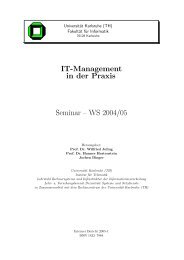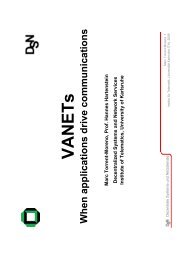Download PDF - KIT
Download PDF - KIT
Download PDF - KIT
Create successful ePaper yourself
Turn your PDF publications into a flip-book with our unique Google optimized e-Paper software.
Traffic<br />
Situation<br />
input<br />
parameter<br />
target<br />
description<br />
Objective<br />
Controller<br />
1<br />
2 3<br />
Result<br />
action<br />
optional feedback<br />
Fig. 2. Analysis of congestion and awareness control algorithms from a<br />
control-theory-based perspective. In general a controller adapts the transmission<br />
parameters, based on its objective and the detected traffic situation,<br />
in order to achieve a particular result. Optionally, the controller makes use<br />
of some sort of feedback with regard to the observed result to optimize its<br />
performance. Depending on the objective (1), e.g. a network-wide limitation<br />
of the channel load or an awareness-range requirement, the scope of the openor<br />
closed-loop controller (2) is either global or local. Consequently, optional<br />
feedback (4) about the result can come from the network or from individual<br />
nodes only (3).<br />
coordination entity in vehicular communications, both processes<br />
are representatives of the distributed control discipline.<br />
For instance, congestion in the network can not be avoided or<br />
reduced if only one single node is decreasing its transmission<br />
power and/or rate, and more importantly, the result of the<br />
selected action can not be observed by the node itself, but only<br />
by its neighbors. That implies that all nodes should — at least,<br />
for an optimal and reliable control — act cooperatively and<br />
provide feedback about the result of their actions to each other.<br />
Similarly, the success of an increased transmission power with<br />
regard to a desired awareness range can only be determined<br />
by the receiving node, and not by the transmitter itself.<br />
Due to the relationship of congestion and awareness control<br />
to traditional control theory, this paper discusses existing proposals<br />
for congestion and awareness control with respect to the<br />
concepts and notions typically used in control theory. For this<br />
purpose, both methods are analyzed and compared according<br />
to the general framework sketched in Figure 2: an algorithm<br />
might use some sort of detection to classify the traffic situation<br />
or scenario which the node is currently in, and which might be<br />
used proactively by the controller as feedforward input. The<br />
controller itself decides how the transmission will be adjusted,<br />
of course depending on the situation and the corresponding<br />
target description, i.e. the current objective. The selected action<br />
then leads to an observable result, which can be fed back to<br />
the controller in order to improve its accuracy.<br />
Based on Figure 2, particular control algorithms are also<br />
classified into open- and closed-loop controllers. The former<br />
do not make use of feedback to correct and optimize the<br />
decisions made in the past, and typically incorporate a system<br />
model to derive the actions to be taken. The advantage of such<br />
a control loop is the nonexisting overhead, but, obviously, the<br />
performance and robustness of such a controller depends on<br />
the accuracy of the system model used. On the contrary, closed<br />
loop controllers employ feedback to determine how well<br />
the objective has been achieved. An often used closed loop<br />
controller is the generic Proportional-Integral-Derivative (PID)<br />
controller, which uses the present error (P), the accumulation<br />
of past errors (I), a prediction of future errors (D), or only a<br />
subset of those measures to control the system. Compared with<br />
4<br />
open loop controllers, closed-loop controllers can improve the<br />
control due to the use of feedback data, at the cost of communications<br />
overhead. In addition, and particularly if a generic<br />
PID controller is used, they do not incorporate any system<br />
model, have no direct knowledge of the underlying process<br />
and perform poorly in non-linear systems. With respect to<br />
feedback, it is also necessary to distinguish between explicit<br />
feedback, i.e., first-order feedback with regard to the desired<br />
result, and implicit feedback, i.e., second-order feedback that<br />
is obtained by using different observations that are to some<br />
extent correlated to the actual observation. A possible implicit<br />
feedback could be, for instance, the locally observed number<br />
of neighbors or MAC layer reception statistics.<br />
Another important aspect is how the design objective can<br />
be quantified and how the achievement of the objective is<br />
measured. When awareness control protocols are used, the<br />
objective could be defined as the reliability with which a<br />
certain vehicle’s awareness range is guaranteed. However, for<br />
congestion control, the question of how to describe the objective<br />
is more difficult to answer, since more than one metric<br />
for channel congestion exists, and all have their advantages<br />
and disadvantages. For instance, the use of a metric such as<br />
the channel busy time ratio, i.e., the fraction of time during<br />
which the channel is considered busy by the access layer, or<br />
the channel load, i.e., the fraction of time during which the<br />
sensed energy exceeds a specific threshold, cannot account<br />
for overlapping transmissions, but has the advantage of being<br />
easily implementable by the communication hardware. On the<br />
other hand, a metric such as the beaconing load [14], though<br />
it does quantify the amount of overlapping packets, is not<br />
directly measurable by the hardware.<br />
IV. CONGESTION CONTROL<br />
Congestion control techniques for vehicular communications<br />
can be classified according to several criteria. The major<br />
classification criterion considers the information base from<br />
which congestion control mechanisms derive their decision<br />
to adjust the transmission parameters. The first class, which<br />
in the literature is sometimes also referred to as reactive<br />
congestion control, uses first-order information about the channel<br />
congestion status to decide whether and how an action<br />
should be undertaken. Due to their nature, actions to lessen<br />
channel load are undertaken only after a congested situation<br />
has been detected. Using control theory terminology, reactive<br />
congestion control approaches can be classified as an instance<br />
of feedback control mechanisms. The second class, sometimes<br />
also referred to as proactive congestion control, uses models<br />
that, based on information such as number of nodes in the<br />
vicinity and data generation patterns, try to estimate transmission<br />
parameters which will not lead to congested channel<br />
conditions, while at the same time providing the desired<br />
application-level performance. In particular, such mechanisms<br />
typically employ a system model to estimate the channel load<br />
under a given set of transmission parameters, and make use of<br />
optimization algorithms to determine the maximum transmit<br />
power and/or rate setting that will adhere to a maximum<br />
congestion limit. Using control theory terminology, proactive<br />
4




